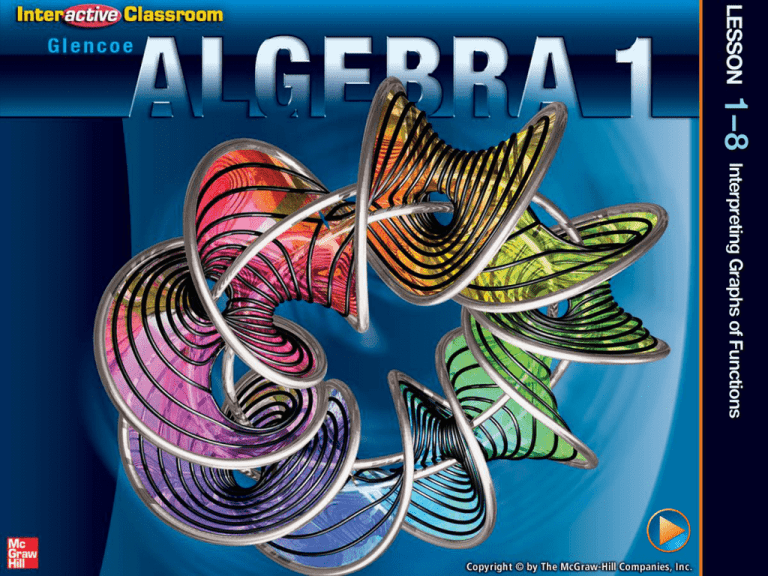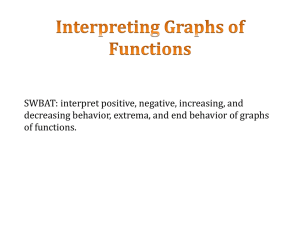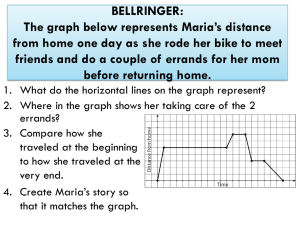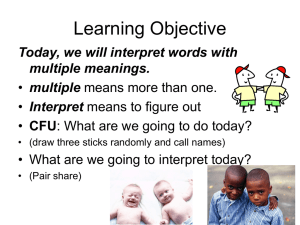
Five-Minute Check (over Lesson 1–7)
CCSS
Then/Now
New Vocabulary
Example 1: Real-World Example: Interpret Intercepts
Example 2: Real-World Example: Interpret Symmetry
Key Concepts: Positive, Negative, Increasing, Decreasing,
Extrema, and End Behavior
Example 3: Real-World Example: Interpret Extrema and End
Behavior
Over Lesson 1–7
Is the relation a function?
A. yes
B. no
Over Lesson 1–7
Is the relation a function?
x
y
16
–8
12
–6
0
0
–4
2
–10
5
A. yes
B. no
Over Lesson 1–7
Is the relation {(7, 0), (0, 7), (–7, 0), (0, –7)}
a function?
A. yes
B. no
Over Lesson 1–7
Is the relation y = 6 a function?
A. yes
B. no
Over Lesson 1–7
If f(x) = 3x + 7, find f(10).
A. 20
B. 23
C. 32
D. 37
Over Lesson 1–7
If g(x) = –2x – 2, find g(–2x).
A.
g(–2x) = 4x – 2
B.
g(–2x) = 4x2 + 4
C.
g(–2x) = 4x2
D.
g(–2x) = 4x2 – 2
Over Lesson 1–7
What is the range shown in this function table?
x
4x + 5
y
–2
4(–2) + 5
–3
0
4(0) + 5
5
1
4(1) + 5
9
A. {–3, 5, 9}
B. {–8, 0, 4}
C. {3, 5, 6}
D. {–2, 0, 1}
Content Standards
F.IF.4 For a function that models a
relationship between two quantities, interpret
key features of graphs and tables in terms of
the quantities, and sketch graphs showing
key features given a verbal description of the
relationship.
Mathematical Practices
1 Make sense of problems and persevere in
solving them.
Common Core State Standards © Copyright 2010. National Governors Association Center for Best Practices and Council of Chief State
School Officers. All rights reserved.
You identified functions and found function
values.
• Interpret intercepts, and symmetry of graphs
of functions.
• Interpret positive, negative, increasing, and
decreasing behavior, extrema, and end
behavior of graphs of functions.
• intercept
• increasing
• x-intercept
• decreasing
• y-intercept
• extrema
• line symmetry
• relative maximum
• positive
• relative minimum
• negative
• end behavior
Interpret Intercepts
COLLEGE The graph shows the cost at a
community college y as a function of the number of
credit hours taken x. Identify the function as linear
or nonlinear. Then estimate and interpret the
intercepts of the graph of the function.
Interpret Intercepts
Answer: Linear or Nonlinear: Since the graph is a
straight line, the graph is linear.
y-Intercept: The graph intersects the y-axis
at about (0, 55), so the y-intercept of the
graph is about 50. This means that the
there is an additional fee of $50 added to
the cost charged per credit hour.
x-Intercept(s): The graph does not
intersect the x-axis. This means that no
amount of credit hours will cost $0.
SALES The graph shows the
expected revenue y as a function of
the price per unit x. Identify the
function as linear or nonlinear. Then
estimate and interpret the intercepts
of the graph of the function.
A.
nonlinear; (0, 100): Zero revenue at a price of $100; (62, 0):
$62 expected revenue at a cost of $0.
B.
nonlinear; (100, 0): Zero revenue at a price of $100; (0, 62):
$62 expected revenue at a cost of $0.
C.
nonlinear; (100, 0): revenue at a price of $0; (0, 62): No
expected revenue at a price of $62 per unit.
D.
nonlinear; (0, 100): revenue at a price of $0; (62, 0): No
expected revenue at a price of $62 per unit.
Interpret Symmetry
MANUFACTURING The graph
shows the cost y to manufacture
x units of a product. Describe
and interpret any symmetry.
Answer: The right half of the graph is the mirror image
of the left half in approximately the line x = 30.
The symmetry of the graph tells you that the
cost to produce n more or n less than 30 units
will be the same.
SALES The graph shows the expected
revenue y as a function of the price per
unit x. Describe and interpret any
symmetry.
A.
B.
C.
D.
The right half of the graph is the mirror
image of the left half in approximately the
line x = 30. The expected revenue at a
price of n more or n less than 30 dollars
per unit will be the same.
The right half of the graph is the mirror image of the left half in
approximately the line x = 3. The expected revenue at a price of n
more or n less than 3 dollars per unit will be the same.
There is no symmetry.
The right half of the graph is the mirror image of the left half in
approximately the line y = 1000. The expected price at a revenue
of n more or n less than 1000 dollars per unit will be the same.
Interpret Extrema and End Behavior
DEER The graph shows the population y of deer x
years after the animals are introduced on an island.
Estimate and interpret where the function is
positive, negative, increasing, and decreasing, the
x-coordinates of any relative extrema, and the end
behavior of the graph.
Interpret Extrema and End Behavior
Answer:
Positive: between x = 0 and about x = 7.5
Negative: for about x > 7.5
This means that there were some deer on the island for almost 8
years after they were introduced to the island.
Increasing: for between about x = 1 and x = 4
Decreasing: for x < 1 and x > 4
This means that the deer population decreased for the first year,
increased for the next three years, then decreased after year 4.
Relative Maximum: at about x = 4
Relative Minimum: at about x = 1
The extrema of the graph indicate that the population experienced a
relative low at year 1 and a relative high at year 4. The population
then decreased to 0 after year 4.
SPEED The graph shows the speed of a car after x
minutes. Estimate and interpret where the function
is positive, negative, increasing, and decreasing,
the x-coordinates of any relative extrema, and the
end behavior of the graph.
A.
positive: 0 < t < 7.2, negative: t > 7.2 minutes;
decreasing: t < 1, 4 < t < 6 , increasing: 1 < t < 4,
t > 6, max: t = 4, min: t = 1 and t = 6
B.
positive: 0 < t < 7.2, negative: t > 7.2 minutes;
increasing: t < 1, 4 < t < 6 , decreasing: 1 < t < 4,
t > 6, max: t = 4, min: t = 1 and t = 6
C.
positive: 0 < t < 7.2, negative: t > 7.2 minutes;
increasing: t < 30, 90 < t < 120 , decreasing:
30 < t < 90, t > 120, max: t = 1, min: t = 4
D.
positive: 0 < t < 7.2, negative: t > 7.2 minutes;
increasing: t < 1, 4 < t < 6 , decreasing: 1 < t < 4,
t > 6, max: t = 1 and t = 6, min: t = 4











